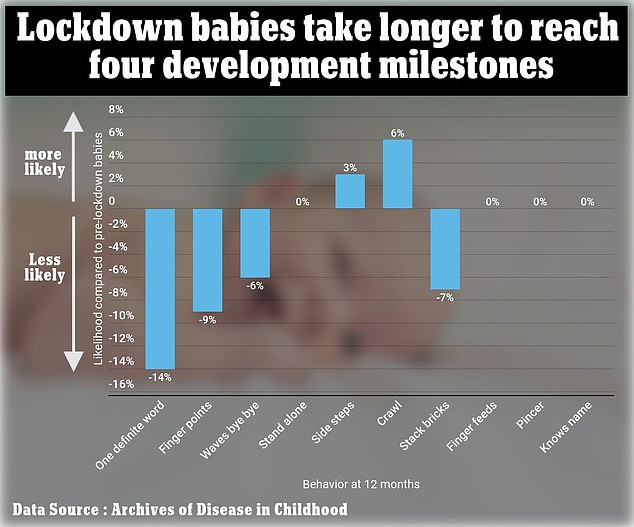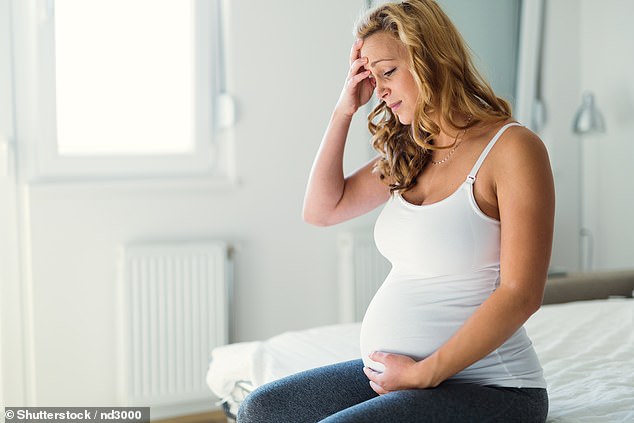Pregnant women stressed during the Covid pandemic gave birth to babies with smaller brains, according to the results of a study that British experts immediately called “alarmist.”
Scientists at Children’s National Hospital in Washington DC said their research, which involved 150 mother-baby pairs, found significant reductions in the brain size of babies born to mothers who had high stress scores during the pandemic.
This included reductions in brain white matter, an inner part of the brain responsible for processing information, the hippocampus area, which governs learning, and the amygdala, areas that govern emotions.
The study authors said this “growth delay” could increase the chances of babies suffering from problems such as anxiety in the future.
However, British specialists poured cold water on the conclusion, saying it was “not supported by the data.”
Scientists at Children’s National Hospital in Washington DC said their study of about 150 mother-baby pairs found significant reductions in brain size in babies born to mothers who had high stress scores during the pandemic (file image)
The study compared the maternal stress scores of two cohorts of mothers (103 before the pandemic and 56 during the pandemic) with brain scans of their babies.
Mothers in the Covid group were about three times as likely to score above thresholds for measuring anxiety, stress and psychological distress compared to their pre-pandemic counterparts.
Their babies’ brains were up to 0.3 cm smaller in the cerebral white matter and hippocampal areas.
The amygdala, the emotional processing centers of the brain, was up to 0.5 cm smaller in babies of mothers stressed during the pandemic.
But Professor Grainne McAlonan, a neuroscience expert at King’s College London, said the findings should be treated with caution.
“In my opinion, this article uses unreasonably alarming language and is not particularly a Covid article,” he said.
“Rather it is a paper about the possible early brain response to maternal stress during pregnancy and, as expected, stress was higher during Covid.”
He added that while the paper found differences in brains, the authors had failed to show what, if anything, they really meant.
“Whether this difference is clinically significant has not been established, there are no results in childhood, so assigning a value to differences in brain volume by using words like ‘stunting’ is totally inappropriate and unsupported.” because of the data,” he said.
“In general, in brain imaging studies, larger brain regions are not necessarily better unless there is a clear relationship between brain size and brain function. The authors do not look at this.
«All that has been shown here is a possible brain response to maternal stress during pregnancy and, furthermore, a very small effect. We can’t say if it’s good or bad.”
Professor McAlonan also noted that data on pandemic mothers was collected between 2020 and 2022.
This, she said, was a long period of difference and that mothers who experienced pregnancy during the height of the 2020 lockdowns likely had a very different experience to those who had babies in 2022.
Another flaw she identified was how mothers’ distress was measured, that is, whether they scored high on a self-reported threshold.
“Distress is complex, variable and exists on a continuum and using this type of limit may not be optimal,” he said.

The graph above shows the probability of a particular behavior in pandemic babies compared to non-pandemic babies when they turn one year old. Pincer refers to the joint use of the thumb and index finger. Pandemic babies were more likely to crawl, but less likely to talk, point or say goodbye
However, he added that more work was needed to answer whether any of the differences seen in the babies’ brains represented any changes in their future development.
None of the women in the smaller pandemic cohort tested positive for the virus during pregnancy.
The authors acknowledged that their study is small and that being composed primarily of highly educated white women may be less relevant to other populations.
Previous studies have linked stress during pregnancy to disruptions in babies’ brain development, which could cause emotional problems later in life.
British researchers previously linked higher levels of the stress hormone cortisol in mothers with structural changes in the amygdala of newborn babies.
Cortisol is involved in the body’s response to stress (higher levels indicate greater stress) and also plays a role in fetal growth.
The amygdala, of which there are two in each hemisphere of the brain, is known to be involved in emotional and social development in childhood.
Multiple studies have also tried to find out if and how babies born in the Covid years differ from their peers, and many have found mixed results.
Some have found that they have an altered gut microbiome (the ecosystem of “good” and “bad” bacteria in the digestive system), which may be leading them to have fewer food allergies and a stronger immune system.
Others have found negatives, such as that young people born during the pandemic were less likely to have said their first words before their first birthday compared to babies born before Covid or to point at objects.
Experts theorize that the above observations may be because mask-wearing during the pandemic limited children’s ability to read facial expressions or see people’s mouth movements, as well as a reduction in socialization. during the lockdowns.

